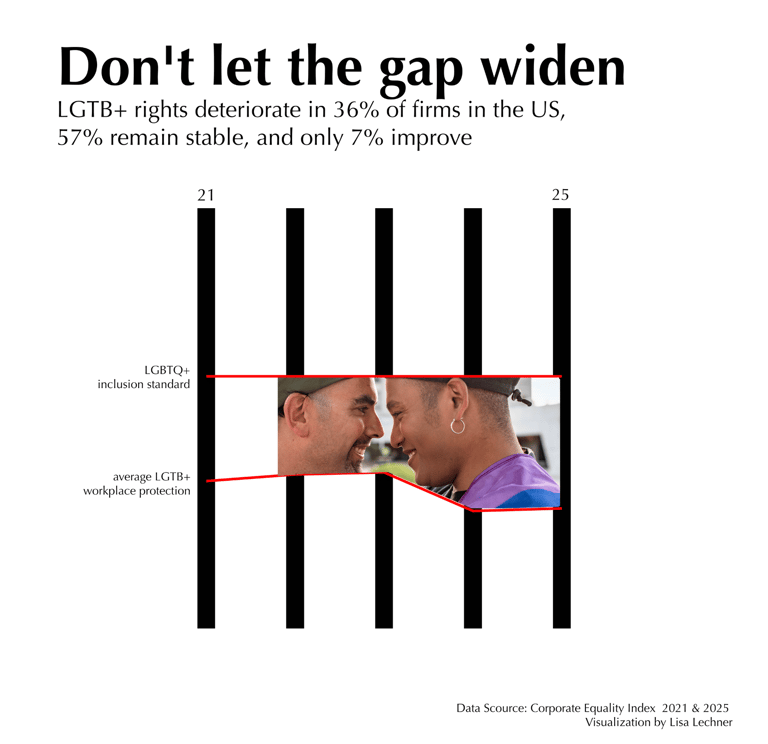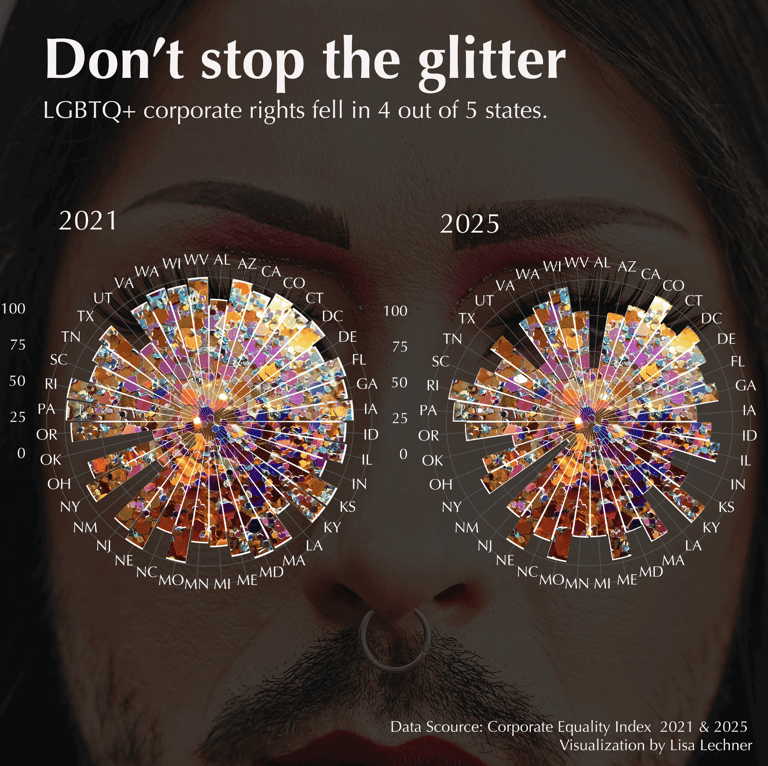Don't Stop the Glitter: The State of LGBTQ+ Corporate Rights in 2025
Pride is louder than ever — in the streets, on social media, in marketing campaigns. But in the places that shape our lives the most — our workplaces — the story is shifting. From 2021 to 2025, LGBTQ+ corporate rights have silently eroded across the US. And while the crowds grow bigger, the protections grow thinner.
Lisa Lechner
7/15/20253 min read
I read a blog post about São Paulo’s Pride parade — it mentioned that over 3.5 million people showed up in 2024. I can’t find the link anymore, but I haven’t forgotten the feeling it gave me. I was hooked. As someone who works with data, I immediately started wondering: What do the world’s biggest Pride parades look like, in numbers? How many people are showing up?
So I started gathering data. I scraped Pride calendars, dug through news archives, cross-checked crowd estimates from local media and official sources, and built a global dataset. Took me quite a while, but digging into it is kinda my character.
Each dot in the visualization I created stands for one heartbeat — one person showing up in pride.
Watching these million dots beat moves me.
While I’ve worked with protest data in other contexts, I always come back to one core question:
How can individuals — and the organizations they’re part of — help shape a better world?
So as I watched millions show up for Pride, I couldn’t help but ask:
What does that kind of collective visibility mean inside companies?
Does it translate into lasting protection — into rights, policies, and everyday culture at work?
That question led me to the Corporate Equality Index (CEI), published annually by the Human Rights Campaign Foundation. It evaluates U.S.-based companies on how inclusive their policies and benefits are toward LGBTQ+ employees — things like anti-discrimination protections, health coverage, family leave, and training.
At first glance, the CEI tells a story of progress. The 2025 report reads:
“Incredible growth in the number of employers that are committed to implementing LGBTQ+ inclusive policies.”
But as a data scientist, I checked the actual numbers — comparing CEI scores from 2021 to 2025.
So while the marketing messages stay loud, the actual protections are quietly eroding — especially at the state level.
During the Biden administration, we began seeing state-level pushback on LGBTQ+ rights. Laws restricting education, gender expression, and DEI programs started surfacing. The shift wasn’t always visible in national policy — but it showed up in the data.
With Trump’s political comeback, this trend has intensified. The backlash isn’t hypothetical — it’s legislative. It’s cultural. And it’s measurable.
Between 2021 and 2025, LGBTQ+ corporate rights declined in 4 out of 5 U.S. states.
The second and third visuals I created reflect this. The glitter fades. The eyelashes thin out. The red gap widens between companies that are progressing and those that are regressing.
In many cases, we’re celebrating Pride in the streets while watching inclusion unravel at work.


What the Data Tells Us — and What It Can’t Fix
To my knowledge, there is no comparable corporate LGBTQ+ dataset outside the U.S. That’s a problem in itself. Measuring inclusion at scale is hard — but not measuring it means not seeing the problem.
I don’t share this to discourage. I share it because data gives us the chance to see clearly. And that’s always the first step to doing better.
The people are showing up. The hearts are there.
But we need companies — and especially company leadership — to back it up. Not with rainbow logos, but with measurable protections, benefits, and safety.
Visibility without policy is performance.
And Pride without protection leaves people vulnerable the moment the cameras are gone.
All visuals and text in this blog post were created by Lisa Lechner. The following scientific publications were used to support the analysis.
Data Source:
Human Rights Campaign Foundation. (2025). Corporate Equality Index. Retrieved from https://www.hrc.org/resources/corporate-equality-index


